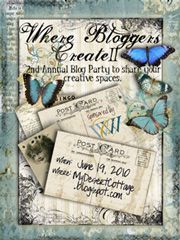
to press (a thing) into or on something.
to produce (a mark, figure, etc.) by pressure; stamp; imprint:
to apply with pressure, so as to leave a mark.
I love art journals. Or, rather, I love the idea of art journals. I've never been able to keep one. I get a few pages in and mess up a page or look back and want to change things around. But I need a place to put sketches and ideas ... So, this is a flexible art journal that can be added to and changed at any time.
The covers of this journal are made of 1/8 inch thick, double sided masonite. I like this as a foundation for small paintings and it's thin enough to work for covers, about the same thickness as book board and very smooth and sturdy. I've cut two pieces of this to approximately 5 x 7 in and drilled three holes in both to fit rings.
I covered most of the masonite with a thin coat of light modeling paste. This will hold impressions made with stamps or anything else. The depth of the stamp will determine how thick the modeling paste should be.
 After letting this dry for about fifteen minutes or so, until it was just starting to harden on the surface, I used rubber and metal stamps dipped in water to stamp into the paste. Here, I've made this a quite subtle effect. But any stamp or any size can be used and thicker or thinner layers of paste.
After letting this dry for about fifteen minutes or so, until it was just starting to harden on the surface, I used rubber and metal stamps dipped in water to stamp into the paste. Here, I've made this a quite subtle effect. But any stamp or any size can be used and thicker or thinner layers of paste.Once dry, I sanded the impressed modeling paste and painted a few thin washes of magenta and turquoise, masking off the stripes with tape.

 On a small, stretched canvas, the effect is more obvious because I've used larger stamps and a thicker layer of paste. The technique is the same ... I used a palette knife to put on a thin coat of modeling paste (which will also act as a resist), allowed it to dry for fifteen minutes or so, then used stamps dipped in water.
On a small, stretched canvas, the effect is more obvious because I've used larger stamps and a thicker layer of paste. The technique is the same ... I used a palette knife to put on a thin coat of modeling paste (which will also act as a resist), allowed it to dry for fifteen minutes or so, then used stamps dipped in water.
Once fully dry, I sanded lightly and did a thin wash with quinacridone magenta.

Added some lime green stripes ...

... and a silk screened moonflower.

I use this technique on large canvases to add text ... and imperfection makes it unique.
What kind of impression will you make?

Karen Valentine, from My Desert Cottage, is having a "Where Bloggers Create" blog party. What a fabulous way to get to know the other bloggers out there! If you'd like to participate, stop in at her blog for the details.






8 comments:
wonderful post!
Thanks for stopping by - isn't Bruce's home just amazing!
Hi Lisa! I’m so happy you will be joining me for the Where Blogger’s Create party this year!
I think it’s going to be great fun and probably bigger than last year!
Jo is offering some great prizes isn’t she??? I’ll be in touch!!
Karen
My Desert Cottage
Valentine Design
SO pretty!
What a great tutorial!. I am a new follower, I love, love your site!! If you get a chance I would love if you could peek at my blog, it is DIY tips, tricks, and secrets. http://thepolkadotcloset.blogspot.com/
Thank you sooo much Carol!
Great idea for the covers of your journal! I like!
This is so cool!
Hi Lisa, I'm a new follower--I went to your Etsy store--exceptional work!! And I love how you show the process on your blog--thank you!!
Very cool to view your process here, and also in your "making a canvas" post! You have the patience of a saint :-)
Post a Comment